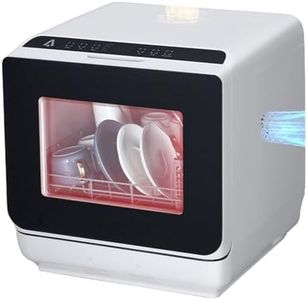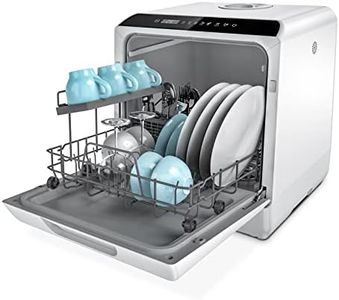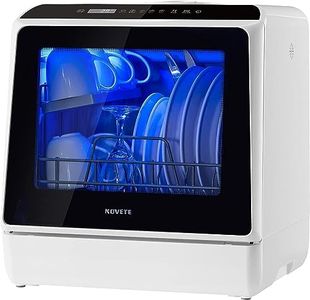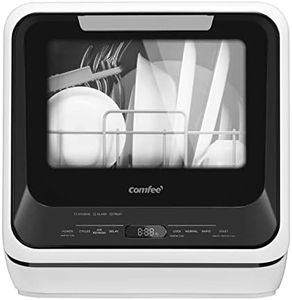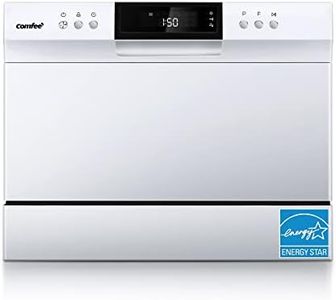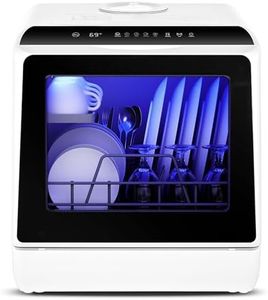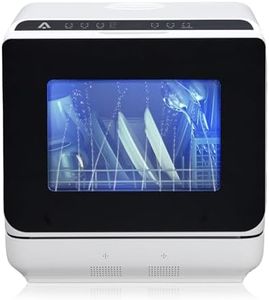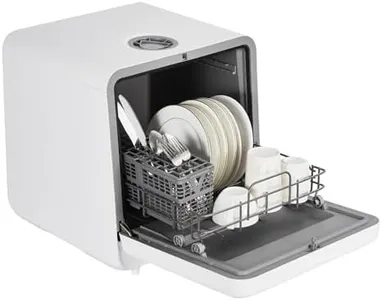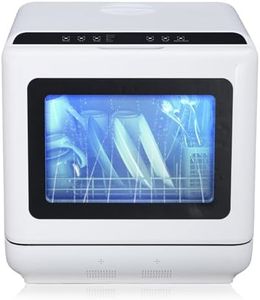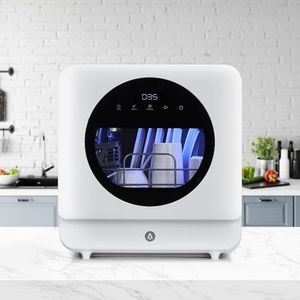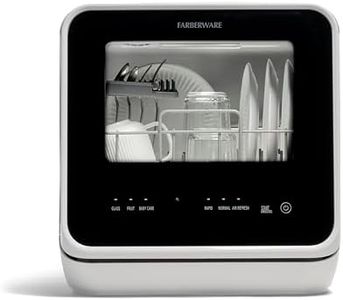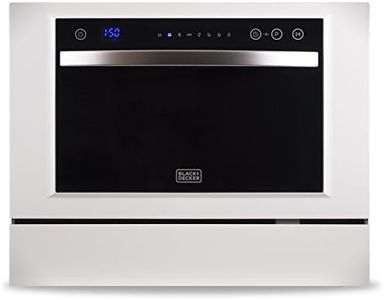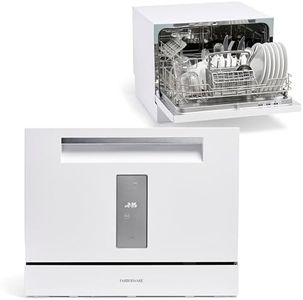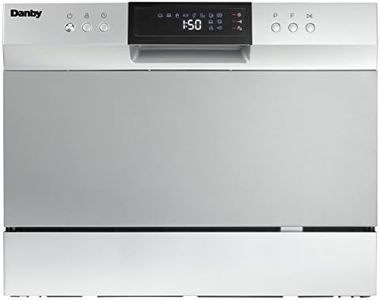10 Best Mini Dishwashers 2025 in the United States
Our technology thoroughly searches through the online shopping world, reviewing hundreds of sites. We then process and analyze this information, updating in real-time to bring you the latest top-rated products. This way, you always get the best and most current options available.

Our Top Picks
Winner
Hermitlux Countertop Dishwasher, 5 Washing Programs Portable Dishwasher With 5-Liter Built-in Water Tank, No Hookup Needed
The Hermitlux Countertop Dishwasher is a compact and handy solution for small households, apartments, dorms, boats, and RVs. Measuring 16.85 x 16.73 x 18.03 inches, it offers a 4 place-setting capacity, accommodating dishes up to 10.25 inches when loaded at an angle. Its portability is emphasized by the built-in 5-liter water tank, allowing for use without a direct water hookup, making it versatile and easy to install on almost any countertop space. However, make sure there's enough clearance (at least 19.88 inches) under your cabinets to fit this unit.
The dishwasher features five wash programs—Standard, Fast, ECO, Strong, and Fruit Cleaning—catering to various cleaning needs. It uses dual high-pressure spraying arms for a thorough clean and a high-temperature drying function to ensure dishes come out dry and spotless. Energy consumption is relatively low at 0.38 kWh per cycle, contributing to better energy efficiency. With a noise level of 50 dB, it operates quietly, which is ideal for small living spaces.
Despite its many strengths, the Hermitlux Countertop Dishwasher has some drawbacks. The dishwasher's plastic material might not appeal to everyone, as it may not provide the same durability as stainless-steel models. Additionally, the 5-liter water tank might require frequent refilling for larger loads. Lastly, some users may find the absence of an integrated funnel inconvenient, though this seems to be a minor issue as it only affects some units due to batch variations.
Customer Highlights
A summary of real customer reviews to highlight what shoppers are saying!NOVETE Portable Countertop Dishwashers, Compact Dishwashers with 5 L Built-in Water Tank & Inlet Hose, 5 Washing Programs, Baby Care, Air-Dry Function and LED Light for Small Apartments
The NOVETE Portable Countertop Dishwasher is a solid choice for those living in small spaces such as apartments, dorms, or RVs. Its compact size (16.9 x 16.8 x 18.1 inches) is a highlight, yet it still manages to accommodate up to 4 place settings, making it suitable for families of 3-4. This versatility allows it to meet daily dishwashing needs without taking up too much space.
One of its key features is its dual water supply options – it can operate using a built-in 5-liter water tank or directly from a faucet. This flexibility is great for users who may not have permanent plumbing connections. The noise level of 50 dB is also relatively quiet, making it suitable for use in shared living spaces.
The dishwasher includes 5 wash programs, including a Baby Care mode that effectively sanitizes baby items and a Speed mode that cleans dishes in just 29 minutes. Additionally, it has a Dry mode with a 60-minute hot air drying feature, which is ideal for ensuring that dishes are ready to use immediately after washing.
Customer Highlights
A summary of real customer reviews to highlight what shoppers are saying!COMFEE' Portable Mini Dishwasher Countertop with 5L Built-in Water Tank for Apartments& RVs, No Hookup Needed, 6 Programs, 360° Dual Spray, 162℉ High-Temp& Air-Dry Function
The COMFEE' Portable Mini Dishwasher is designed for those with limited space, making it a great option for small apartments, RVs, and even dorms. It has a compact design, allowing it to fit comfortably on a countertop while still accommodating about 30 items, including 9.5-inch plates. One of its big advantages is the 5L built-in water tank, which means you don't need a direct water hookup; you can use it anywhere. Additionally, it offers six wash programs like Normal, Rapid, and Hygiene, catering to various cleaning needs. The high-temperature cycles can effectively tackle tough stains and sanitize items like baby bottles, which is an added bonus for parents.
On the flip side, this dishwasher has some drawbacks to consider. The noise level is at 62 dB, which might be a bit loud for some users, especially in smaller living spaces. Also, while it has a decent energy consumption rate of 130 kWh per year, it's important to remember that it still uses about 1.32 gallons of water per hour, which is higher compared to some full-sized models.
Another aspect to keep in mind is that you need to use the right type of dishwasher detergent; regular liquid soap can cause problems, which may be inconvenient for some. Installation is simple, but you need to ensure there’s enough space between your countertop and the wall cupboard to fit the unit comfortably. Lastly, while the drying performance is aided by the Air Refresh function, some users may still find it doesn't completely dry larger items.
Customer Highlights
A summary of real customer reviews to highlight what shoppers are saying!Buying Guide for the Best Mini Dishwashers
Choosing the right mini-dishwasher can make your life much easier, especially if you have limited space or a smaller household. Mini-dishwashers are compact, efficient, and can save you time and effort. When selecting a mini-dishwasher, it's important to consider several key specifications to ensure you get the best fit for your needs. Understanding these specs will help you make an informed decision and find a model that suits your lifestyle and kitchen setup.FAQ
Most Popular Categories Right Now
